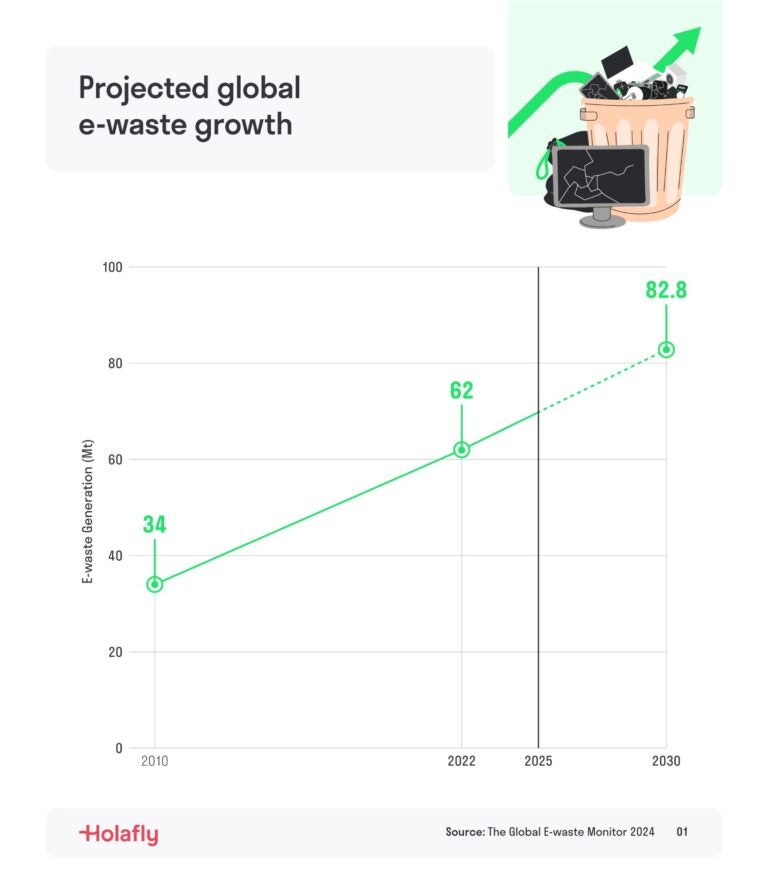The world’s e-waste capitals
Norway generates the most e-waste per person globally. Find out the world's other e-waste capitals and how eSIMs can reduce your e-waste footprint.
From your old smartphone to your broken printer, e-waste is everywhere. As our appetite for new technology grows, so does the amount of discarded electronics.
Electronic waste is in fact one of the fastest-growing waste streams, making it a challenge for governments, corporations and households around the world.
Whilst many e-waste regulations and legislations are now in place to try and manage the collection and recycling rates, a large proportion still ends up in landfills around the world.
Why does e-waste matter?
E-waste is more than just bits of old broken tech. It also includes valuable materials, many of which are toxic, like lead and mercury. Without proper recycling, these substances can leak into soil and water, harming ecosystems and putting human health at risk.
It has become a global challenge with huge consequences not just for the environment, but for the economy too.
In the US, managing e-waste isn’t just about disposing of it appropriately. Lawmakers see it as a way to reduce dependence on China, which currently handles most of the world’s lithium, cobalt, and other critical minerals. By recycling electronics, the US can recover valuable materials like gold, copper, and lithium and reduce the need for mining.
Given the rise of e-waste around the world and Holafly’s commitment to a more eco-friendly world for all travelers, the Research Team has analyzed the numbers to highlight and raise awareness of the e-waste issue and to show which countries generate and recycle the most e-waste.
Key takeaways from our findings
- At the current annual growth rate, global e-waste is set to rise to 82 million tonnes by 2030
- Overall, just 22% of global e-waste is formally collected and recycled each year
- Small appliances such as microwaves and kettles generate the largest amount of e-waste, but only about 12% of that is actually recycled
- Norway generates the most e-waste per person at 26.8 kg per capita, followed closely by the United Kingdom (24.5 kg) and Switzerland (23.4 kg)
- On the other hand, Bulgaria tops the list for e-waste recycling rates, collecting an impressive 84% of its electronic waste, followed closely by Poland (81%)
Will global e-waste continue to rise?
The scale of e-waste produced around the world is increasing at an alarming rate. According to the Global E-Waste Monitor, a record 62 million tonnes (Mt) of e-waste was produced in 2022, up 82% from 2010.
At the current annual growth rate, global e-waste is on track to rise another 32%, to 82.8 million tonnes by 2030. In fact, the amount of e-waste produced worldwide rises by about 2.6 million tonnes each year.

But the bigger issue isn’t just the volume of electronic waste, it’s what is happening to all of this waste.
What types of equipment generate the most e-waste?
Not all electronics contribute equally to the global e-waste problem. Some generate huge amounts of waste but are recycled at much lower rates.
Therefore understanding which types of devices generate the most waste and which are recycled the least can help us think of ways we can tackle the problem.

Small appliances like vacuum cleaners, microwaves, and kettles generate the largest amount of e-waste, totaling 20.4 billion kg globally each year, but only about 12% of that is actually recycled. Other types of devices also contribute significantly. Small IT and telecommunication equipment such as mobile phones and SIM cards generate around 4.6 billion kg of e-waste globally each year but only 22% is recycled.
This shows that even the smallest everyday tech can have an environmental impact. Take SIM cards for example. Although small, each one generates approximately 0.5 grams of e-waste due to its plastic and microchip components, and with more than 5.3 billion SIM cards shipped worldwide in 2018, that resulted in nearly 2,700 metric tons of e-waste in a single year. While this number may seem small compared to major electronic products and devices, it still represents a significant environmental concern due to the sheer volume of SIM cards produced globally.
The shift to eSIM technology is helping to tackle this issue. First introduced to consumers in 2016 and rolled out in popular devices like the Google Pixel 2 and iPhone XR in 2017, eSIM device compatibility has continued to grow and eliminate the need for physical cards altogether.
Adoption has grown rapidly, enabling more space-efficient device designs, improving connectivity, and significantly reducing plastic waste. In fact, with Apple’s recent launch of the iPhone 17, its first ever eSIM-only device, it demonstrates their full commitment to a more connected and sustainable future.
Overall, just 22% of global e-waste is formally collected and recycled each year. That leaves billions of kilos of valuable materials unused that could help the environment and the economy.
Which countries produce the most e-waste?
When it comes to the countries that produce the most e-waste per capita, European countries dominate the top of the list. Norway generates the most e-waste per person at 26.8 kg per capita, followed closely by the United Kingdom (24.5 kg) and Switzerland (23.4 kg).
Other European countries high up the list include France, Iceland, Denmark, the Netherlands, and Belgium, all producing more than 21 kg per person each year.
Outside of Europe, Australia (22.4 kg) and the United States (21.3 kg) also contribute significantly, while Japan (21.2 kg) and Taiwan (19.4 kg) are the highest e-waste producers in Asia.

Which countries recycle the most e-waste?
When it comes to recycling e-waste, research from the Global E-Waste Monitor reports that Bulgaria tops the list, collecting a huge 84% of its electronic waste, followed closely by Poland (81%).
Bulgaria’s effective e-waste management comes down to a number of policies that have been put in place. These include the Extended Producer Responsibility (EPR) framework, where manufacturers are responsible for the entire lifecycle of their products, ensuring that they are collected, recycled or safely disposed of.
Other countries that score high for their recycling rates include Austria and Finland (both 76%), and Norway (74%). Sweden, Czech Republic, Croatia, Belgium and Hungary all collect at least 65% of their e-waste.

Tips on reducing e-waste
Here are some practical steps on how you can make a meaningful impact to help reduce e-waste:
- Recycle responsibly – Always dispose of your electronic devices at e-waste recycling centers. These facilities ensure that valuable materials are recovered and hazardous substances are handled safely.
- Opt for an eSIM – eSIMs help reduce electronic waste by eliminating the need for physical SIM cards. This cuts down on the production of plastic and metal while also reducing packaging waste. Not only that, as eSIMs are digital, they can be installed instantly, offering a better solution to stay connected wherever you go.
- Expand the lifespan of your technology – Instead of upgrading to the latest models, consider maintaining and repairing them. Regular maintenance and repairs can extend the life of your electronics, reducing the need to replace them.
- Look for sustainable tech – Choose products from companies committed to sustainability. Many tech brands now offer eco-friendly devices designed for longevity and recyclability, helping to reduce the overall environmental impact of electronics.
Taking action against e-waste
E-waste is a growing global problem. Our report highlights that we throw away huge amounts of electronics each year, but only a small portion are actually recycled.
By making better choices and learning from top countries when it comes to e-waste recycling, we can all help reduce e-waste, protect resources and create a cleaner future.
Methodology
To provide a comprehensive overview of global e-waste generation and recycling, we utilized data from two authoritative sources: the Global E-Waste Monitor 2024 and the Global E-Waste Statistics Partnership. All data collected September 2025.





 Language
Language 


















 No results found
No results found









